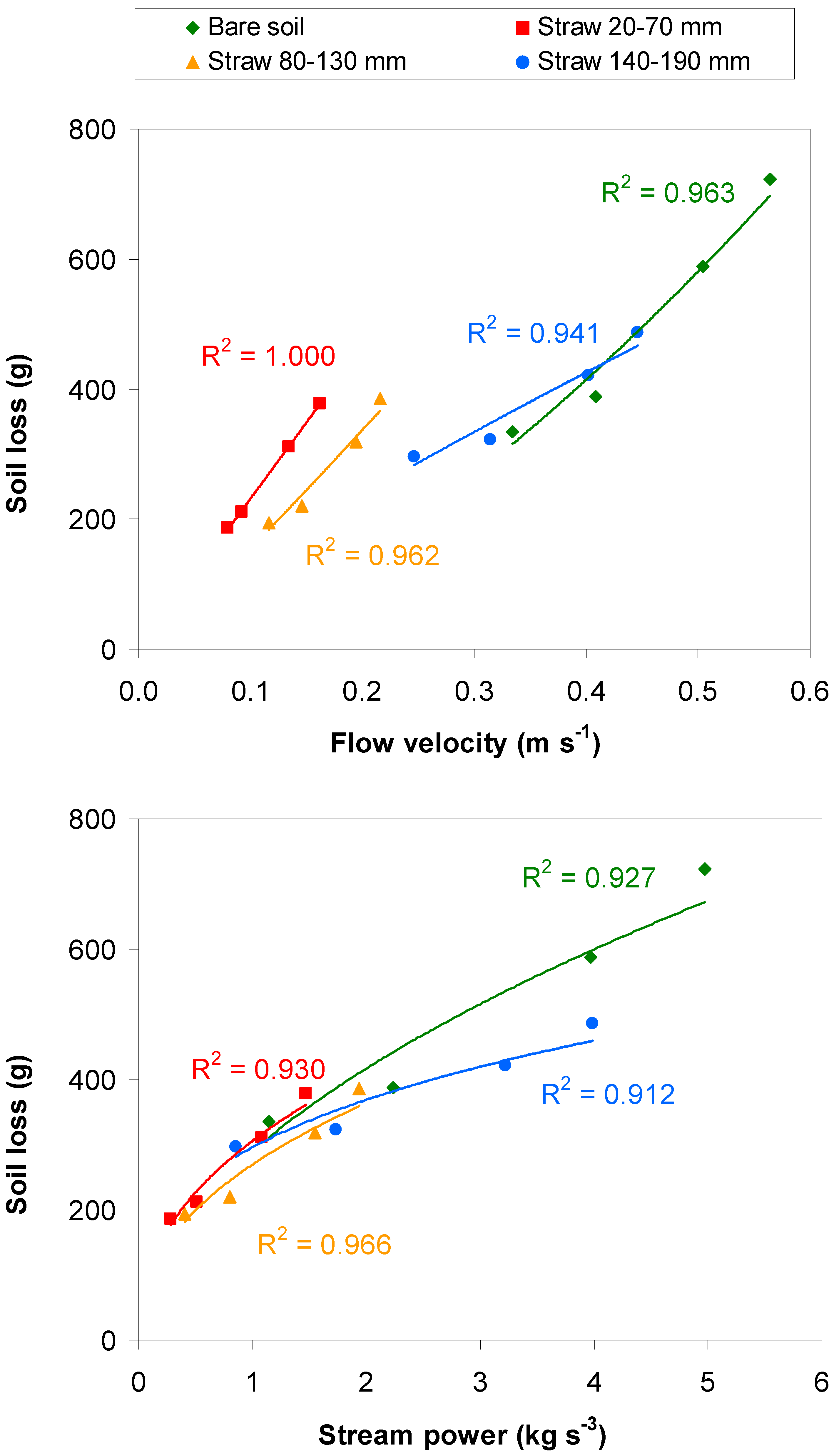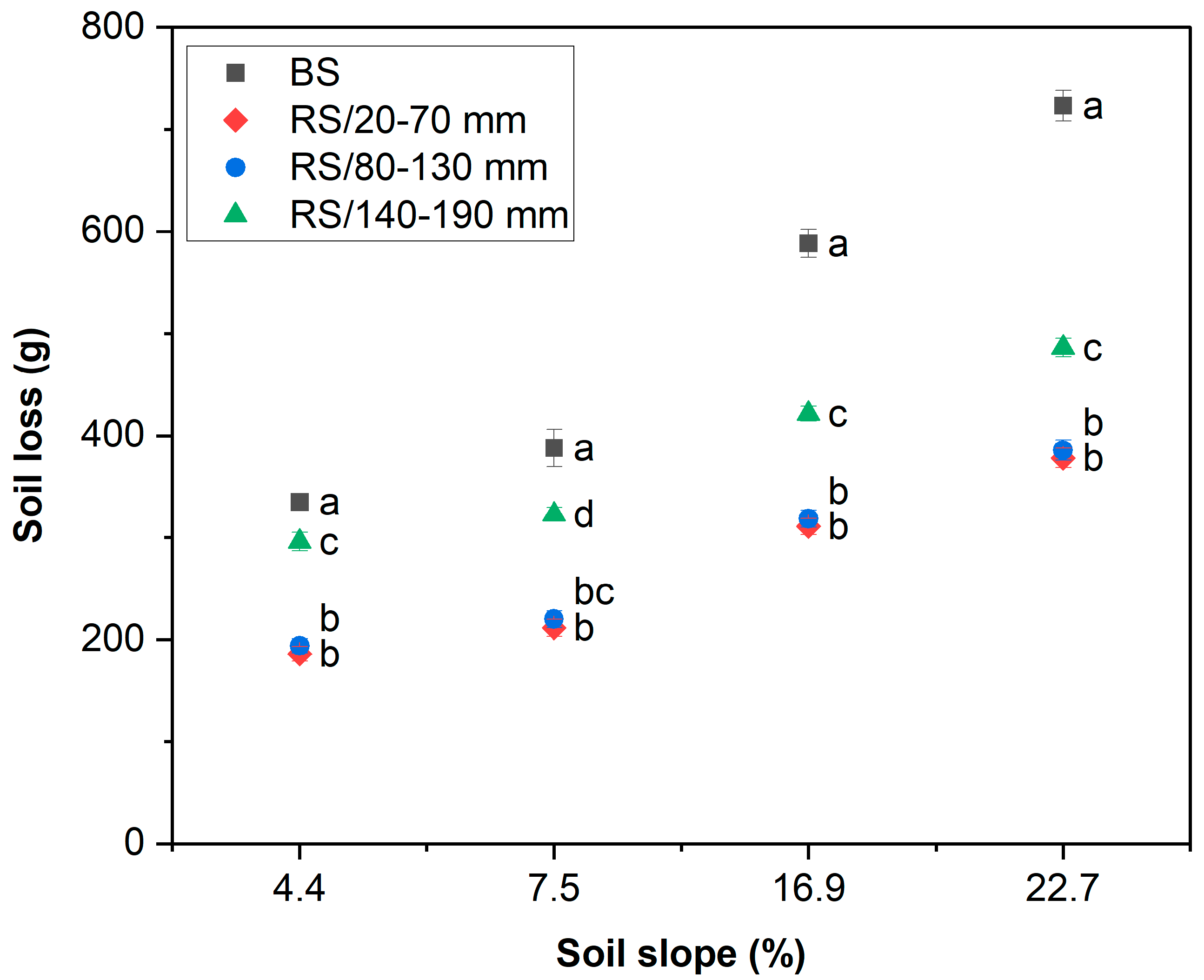Effects of Rice Straw Size on Flow Velocity and Rill Erosion: A Laboratory-Scale Experiment
Abstract
1. Introduction
2. Materials and Methods
2.1. Study Area
2.2. Soil Sampling and Flume Experiments
2.3. Flume Experiments
2.4. Experimental Design
2.5. Statistical Analysis
3. Results
3.1. Variability of Flow Velocity, Stream Power and Soil Loss with Soil Condition and Slope
3.2. Relationships Among Soil Loss, Flow Velocity, and Stream Power Under Variable Soil Conditions and Slope

4. Discussion
4.1. Variability of Flow Velocity, Stream Power and Soil Loss with Soil Condition and Slope
4.2. Relationships Among Soil Loss, Flow Velocity and Stream Power Under Variable Soil Conditions and Slope
4.3. Practical Implications and Main Limitations
5. Conclusions
Author Contributions
Funding
Data Availability Statement
Conflicts of Interest
References
- Bhattacharyya, P.; Bisen, J.; Bhaduri, D.; Priyadarsini, S.; Munda, S.; Chakraborti, M.; Adak, T.; Panneerselvam, P.; Mukherjee, A.K.; Swain, S.L. Turn the Wheel from Waste to Wealth: Economic and Environmental Gain of Sustainable Rice Straw Management Practices over Field Burning in Reference to India. Sci. Total Environ. 2021, 775, 145896. [Google Scholar] [CrossRef]
- Donjadee, S.; Tingsanchali, T. Soil and Water Conservation on Steep Slopes by Mulching Using Rice Straw and Vetiver Grass Clippings. Agric. Nat. Resour. 2016, 50, 75–79. [Google Scholar] [CrossRef]
- Parhizkar, M.; Shabanpour, M.; Lucas-Borja, M.E.; Zema, D.A.; Li, S.; Tanaka, N.; Cerda, A. Effects of Length and Application Rate of Rice Straw Mulch on Surface Runoff and Soil Loss under Laboratory Simulated Rainfall. Int. J. Sediment Res. 2021, 36, 468–478. [Google Scholar] [CrossRef]
- Park, S.-I.; Yang, H.I.; Park, H.-J.; Seo, B.-S.; Jeong, Y.-J.; Lim, S.-S.; Kwak, J.-H.; Kim, H.-Y.; Yoon, K.-S.; Lee, S.-M. Rice Straw Cover Decreases Soil Erosion and Sediment-Bound C, N, and P Losses but Increases Dissolved Organic C Export from Upland Maize Fields as Evidenced by δ13C. Sci. Total Environ. 2021, 753, 142053. [Google Scholar] [CrossRef]
- Abrantes, J.R.; Prats, S.A.; Keizer, J.J.; de Lima, J.L. Effectiveness of the Application of Rice Straw Mulching Strips in Reducing Runoff and Soil Loss: Laboratory Soil Flume Experiments under Simulated Rainfall. Soil Tillage Res. 2018, 180, 238–249. [Google Scholar] [CrossRef]
- Fakhari, M.A.; Lotfalian, M.; Khaledi Darvishan, A. Effect of Rice Straw and Wood Chips on Soil Erosion and Seedling Growth on the Fill Slope of Forest Roads. Environ. Eros. Res. J. 2018, 8, 104–118. [Google Scholar]
- Prats, S.A.; Malvar, M.C.; Vieira, D.C.S.; MacDonald, L.; Keizer, J.J. Effectiveness of Hydromulching to Reduce Runoff and Erosion in a Recently Burnt Pine Plantation in Central Portugal. Land Degrad. Dev. 2016, 27, 1319–1333. [Google Scholar] [CrossRef]
- Chen, S.; Zhang, G.; Wang, C. How Does Straw-Incorporation Rate Reduce Runoff and Erosion on Sloping Cropland of Black Soil Region? Agric. Ecosyst. Environ. 2023, 357, 108676. [Google Scholar] [CrossRef]
- Mannering, J.; Meyer, L.D. The Effects of Various Rates of Surface Mulch on Infiltration and Erosion. Soil Sci. Soc. Am. J. 1963, 27, 84–86. [Google Scholar] [CrossRef]
- Dalir, P.; Naghdi, R.; Gholami, V. Assessing the Rice Straw Effects on the Soil Erosion Rate in Forest Road Cut Slope Embankments. Casp. J. Environ. Sci. 2021, 19, 325–339. [Google Scholar]
- Gao, Z.; Xu, Q.; Si, Q.; Zhang, S.; Fu, Z.; Chen, H. Effects of Different Straw Mulch Rates on the Runoff and Sediment Yield of Young Citrus Orchards with Lime Soil and Red Soil under Simulated Rainfall Conditions in Southwest China. Water 2022, 14, 1119. [Google Scholar] [CrossRef]
- de Lima, J.L.; Santos, L.; Mujtaba, B.; de Lima, M.I.P. Laboratory Assessment of the Influence of Rice Straw Mulch Size on Soil Loss. Adv. Geosci. 2019, 48, 11–18. [Google Scholar] [CrossRef]
- Govers, G.; Giménez, R.; Van Oost, K. Rill Erosion: Exploring the Relationship between Experiments, Modelling and Field Observations. Earth-Sci. Rev. 2007, 84, 87–102. [Google Scholar] [CrossRef]
- Knapen, A.; Poesen, J.; Govers, G.; Gyssels, G.; Nachtergaele, J. Resistance of Soils to Concentrated Flow Erosion: A Review. Earth-Sci. Rev. 2007, 80, 75–109. [Google Scholar] [CrossRef]
- Parhizkar, M.; Shabanpour, M.; Khaledian, M.; Cerdà, A.; Rose, C.W.; Asadi, H.; Lucas-Borja, M.E.; Zema, D.A. Assessing and Modeling Soil Detachment Capacity by Overland Flow in Forest and Woodland of Northern Iran. Forests 2020, 11, 65. [Google Scholar] [CrossRef]
- Kottek, M.; Grieser, J.; Beck, C.; Rudolf, B.; Rubel, F. World Map of the Köppen-Geiger Climate Classification Updated. Meteorolog. Z. 2006, 15, 259–263. [Google Scholar] [CrossRef]
- Zhang, G.-H.; Liu, G.-B.; Tang, K.-M.; Zhang, X.-C. Flow Detachment of Soils under Different Land Uses in the Loess Plateau of China. Trans. ASABE 2008, 51, 883–890. [Google Scholar] [CrossRef]
- Abrahams, A.D.; Parsons, A.J.; Luk, S.-H. Field Measurement of the Velocity of Overland Flow Using Dye Tracing. Earth Surf. Process. Landf. 1986, 11, 653–657. [Google Scholar] [CrossRef]
- Parhizkar, M.; Shabanpour, M.; Zema, D.A.; Lucas-Borja, M.E. Rill Erosion and Soil Quality in Forest and Deforested Ecosystems with Different Morphological Characteristics. Resources 2020, 9, 129. [Google Scholar] [CrossRef]
- Nearing, M.A.; Bradford, J.M.; Parker, S.C. Soil Detachment by Shallow Flow at Low Slopes. Soil Sci. Soc. Am. J. 1991, 55, 339–344. [Google Scholar] [CrossRef]
- Nearing, M.A.; Norton, L.D.; Bulgakov, D.A.; Larionov, G.A.; West, L.T.; Dontsova, K.M. Hydraulics and Erosion in Eroding Rills. Water Resour. Res. 1997, 33, 865–876. [Google Scholar] [CrossRef]
- Bazzoffi, P. Soil Erosion Tolerance and Water Runoff Control: Minimum Environmental Standards. Reg. Environ. Change 2009, 9, 169–179. [Google Scholar] [CrossRef]
- Wischmeier, W.H.; Smith, D.D. Rainfall Energy and Its Relationship to Soil Loss. Eos Trans. Am. Geophys. Union 1958, 39, 285–291. [Google Scholar]
- Cater, J.R.; Donald, W.N.; Perez, M.; Fang, X. Evaluation of Straw Mulch as an Erosion Control Practice for Varying Soil Types on a 4: 1 Slope. Water 2024, 16, 2819. [Google Scholar] [CrossRef]
- Wang, J.-F.; Yang, Y.-F.; Wang, B.; Liu, G.-B.; Li, J.-M. Soil Detachment Caused by Flowing Water Erosion in Six Typical Herbaceous Plant Root Systems on the Loess Plateau, China. Biosyst. Eng. 2022, 217, 56–67. [Google Scholar] [CrossRef]
- Ma, J.; Ma, B.; Wang, C.; Wang, Y.; Li, C.; Fan, S. Wheat Straw Reduces Runoff, Sediment Yield and Flow Velocity in Sloping Farmland under Two Straw Mulching Methods. Plant Soil 2023, 483, 355–377. [Google Scholar] [CrossRef]
- Singh, Y.; Sharma, S.; Kumar, U.; Sihag, P.; Balyan, P.; Singh, K.P.; Dhankher, O.P. Strategies for Economic Utilization of Rice Straw Residues into Value-Added by-Products and Prevention of Environmental Pollution. Sci. Total Environ. 2024, 906, 167714. [Google Scholar] [CrossRef] [PubMed]
- Liu, H.; Wang, Z.; Xu, W.; Zeng, J.; Li, L.; Li, S.; Gao, Z. Bacillus Pumilus LZP02 Promotes Rice Root Growth by Improving Carbohydrate Metabolism and Phenylpropanoid Biosynthesis. Mol. Plant. Microbe Interact. 2020, 33, 1222–1231. [Google Scholar] [CrossRef] [PubMed]
- Yang, L.; Duan, J.; Peng, L.; Zhang, X.; Guo, X.; Yang, J. Effects of Straw Mulching on Near-Surface Hydrological Process and Soil Loss in Slope Farmland of Red Soil. Water 2022, 14, 3388. [Google Scholar] [CrossRef]
- Rahma, A.E.; Wang, W.; Tang, Z.; Lei, T.; Warrington, D.N.; Zhao, J. Straw Mulch Can Induce Greater Soil Losses from Loess Slopes than No Mulch under Extreme Rainfall Conditions. Agric. For. Meteorol. 2017, 232, 141–151. [Google Scholar] [CrossRef]
- Prats, S.A.; Wagenbrenner, J.W.; Martins, M.A.S.; Malvar, M.C.; Keizer, J.J. Hydrologic Implications of Post-Fire Mulching Across Different Spatial Scales. Land Degrad. Dev. 2016, 27, 1440–1452. [Google Scholar] [CrossRef]
- Bombino, G.; Denisi, P.; Gómez, J.A.; Zema, D.A. Water Infiltration and Surface Runoff in Steep Clayey Soils of Olive Groves under Different Management Practices. Water 2019, 11, 240. [Google Scholar] [CrossRef]
- Prosdocimi, M.; Tarolli, P.; Cerdà, A. Mulching Practices for Reducing Soil Water Erosion: A Review. Earth-Sci. Rev. 2016, 161, 191–203. [Google Scholar] [CrossRef]
- Parhizkar, M.; Lucas-Borja, M.E.; Zema, D.A. Changes in Rill Detachment Capacity after Deforestation and Soil Conservation Practices in Forestlands of Northern Iran. CATENA 2024, 246, 108405. [Google Scholar] [CrossRef]
- Wang, J.; Shi, X.; Li, Z.; Zhang, Y.; Liu, Y.; Peng, Y. Responses of Runoff and Soil Erosion to Planting Pattern, Row Direction, and Straw Mulching on Sloped Farmland in the Corn Belt of Northeast China. Agric. Water Manag. 2021, 253, 106935. [Google Scholar] [CrossRef]




| Factor | Degrees of Freedom | Sum of Squares | Mean Square | F-Value | p-Value |
|---|---|---|---|---|---|
| Flow velocity | |||||
| Soil condition | 3 | 1.52 | 0.51 | 45.2 | <0.0001 |
| Soil slope | 3 | 0.22 | 0.07 | 6.50 | 0.001 |
| Interaction | 9 | 0.04 | 0.00 | 0.42 | 0.92 |
| Stream power | |||||
| Soil condition | 3 | 68.3 | 22.8 | 10.1 | <0.0001 |
| Soil slope | 3 | 65.6 | 21.9 | 9.67 | <0.0001 |
| Interaction | 9 | 13.6 | 1.51 | 0.67 | 0.73 |
| Soil loss | |||||
| Soil condition | 3 | 736,335 | 245,445 | 2193 | <0.0001 |
| Soil slope | 3 | 745,744 | 248,581 | 2221 | <0.0001 |
| Interaction | 9 | 93,867 | 10,430 | 93.2 | <0.0001 |
Disclaimer/Publisher’s Note: The statements, opinions and data contained in all publications are solely those of the individual author(s) and contributor(s) and not of MDPI and/or the editor(s). MDPI and/or the editor(s) disclaim responsibility for any injury to people or property resulting from any ideas, methods, instructions or products referred to in the content. |
© 2025 by the authors. Licensee MDPI, Basel, Switzerland. This article is an open access article distributed under the terms and conditions of the Creative Commons Attribution (CC BY) license (https://creativecommons.org/licenses/by/4.0/).
Share and Cite
Parhizkar, M.; Lucas-Borja, M.E.; Zema, D.A. Effects of Rice Straw Size on Flow Velocity and Rill Erosion: A Laboratory-Scale Experiment. Environments 2025, 12, 421. https://doi.org/10.3390/environments12110421
Parhizkar M, Lucas-Borja ME, Zema DA. Effects of Rice Straw Size on Flow Velocity and Rill Erosion: A Laboratory-Scale Experiment. Environments. 2025; 12(11):421. https://doi.org/10.3390/environments12110421
Chicago/Turabian StyleParhizkar, Misagh, Manuel Esteban Lucas-Borja, and Demetrio Antonio Zema. 2025. "Effects of Rice Straw Size on Flow Velocity and Rill Erosion: A Laboratory-Scale Experiment" Environments 12, no. 11: 421. https://doi.org/10.3390/environments12110421
APA StyleParhizkar, M., Lucas-Borja, M. E., & Zema, D. A. (2025). Effects of Rice Straw Size on Flow Velocity and Rill Erosion: A Laboratory-Scale Experiment. Environments, 12(11), 421. https://doi.org/10.3390/environments12110421










